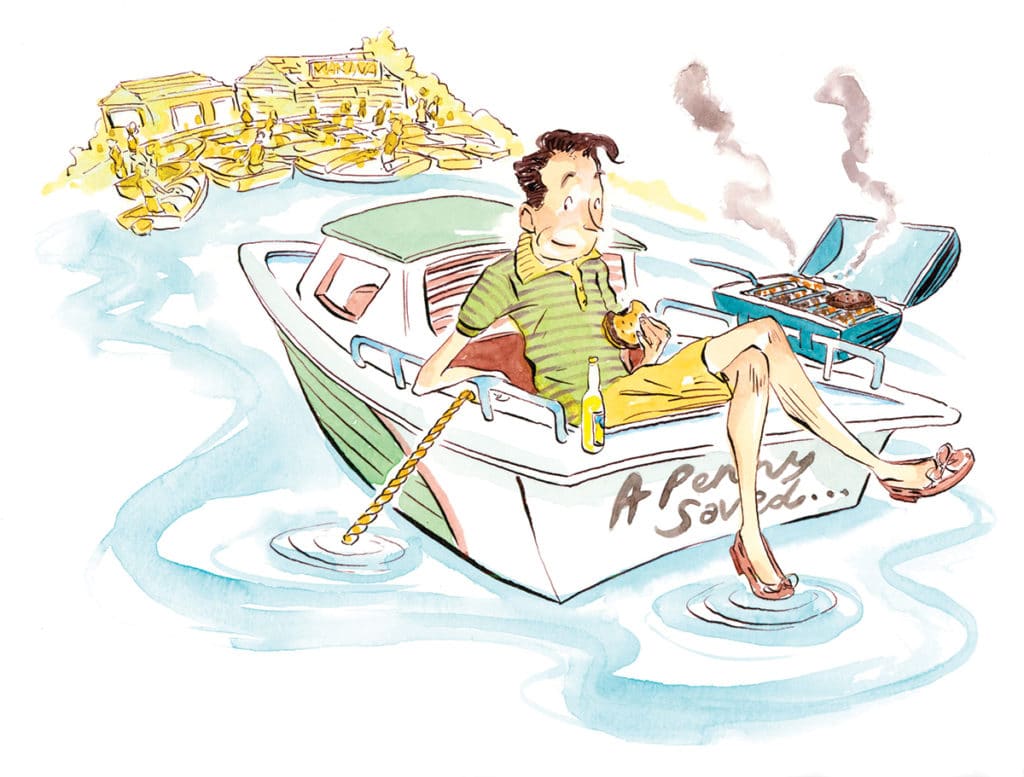
Admit it. Given the choice of spending the night at a marina packed in like a mall parking lot on Dec. 24 or anchored in a quiet empty cove, you’d go for the marina. We can’t help it; that’s what we do. But why? I thought the idea of boating was to get away from it all.
Sailboaters anchor out all the time and love it. Of course, a unique type of cheapness mostly motivates this. I’ve seen them drop the hook, dinghy in to a marina, and then argue with the dockmaster about paying a $12 landing fee so they can go ashore for a $150 dinner. The irony is that these are the boats that should be tied up in marinas. Their cabins are smaller than Superman’s phone booth, and on windy days they can wander about their moorings as if lost.
Most 28-foot power cruisers have as much room as a 35-foot sailboat and a lot more amenities — so there’s no need to go ashore. Yet we still huddle together, looking into each other’s cabin windows, and at night listen to the occasional stream of water from the next boat — hoping that it’s just the air-conditioner discharge. So this season break free, cut those marina umbilical cords, and take some lessons from our windblown cousins.
First, you don’t need shore power. And forget gensets. Who wants yet another engine or fuel tank? Inverters turn 12 volts DC into 110 volts AC. There is no maintenance, and they are easy to install and are the size of a small TV cable box. But they do need to be backed up by a sizable bank of batteries. I’d have at least 300 amp-hours for a 1,500-watt inverter. One this size is common on long-distance cruisers and costs only about one-tenth the price of a genset. Keep the battery cables thick and short and you’ll do fine. However, if your daily AC draw is more than 2,000 watt-hours, you’ll need a genset, but it’s a lot smarter to look for ways to cut back your consumption.
Next, chuck the electric stove and put in one that uses propane. Propane is cheap and available worldwide. It heats food quickly, can be finely adjusted, and shuts off instantly (important when a pot boils over).
Another sailboat trick is to get rid of the front-opening 110/12-volt refrigerator. It dumps all the cold out when you open it and drains the batteries. Replace it with a permanently installed top-loading ice chest. Put a holding plate inside and run its remote compressor off the engine’s pulleys or the batteries. Those Coronas will now ice over when opened, and your power draw will be cut to nil. Adler/Barbour has been making this type of marine refrigeration for decades.
You need air conditioning in a marina, but when anchored out there’s nothing blocking those cool sea breezes. So why bother with the noise, cost, and use of all that space below for the unit and ducting? Put in some cabin screens, DC fans and a cockpit sunshade. Attach a Breeze Booster to the foredeck hatch for a force-five blow below.
Marina water tastes like it comes from a garden hose — which it does. In the South it smells like sulfur, and in the Bahamas you’re charged for it. The best water on Earth comes from the sky. Add a plastic through-hull fitting in your Bimini top and some clear hose to the tank, and you have a rain catcher. A short summer shower will fill your tank. Fire your water heater by running the engine, or install an on-demand propane heater.
Now the only reason for staying at a marina is companionship, which you probably get too much of during the week anyway. So, the next time I see you outside the inlet, I hope you’re on your way to anchoring out.









